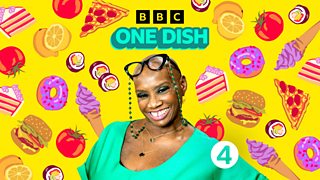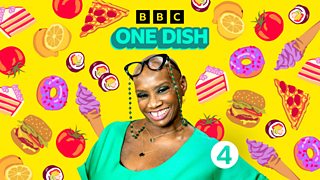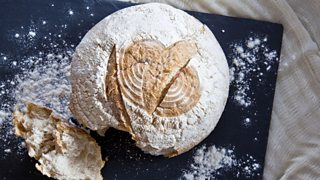The surprising history of soda bread
In ���˿��� Radio 4 podcast One Dish, chef Andi Oliver talks to a famous guest about a food that holds meaning for them. They unpack its secrets, from the history behind how it came to exist, to what memories and associations make it so special. Plus, psychologist and nutritionist Kimberley Wilson pops in to give some scientific insight.
In the first episode, Andi meets former Bake Off contestant, presenter and cookery writer Briony May Williams to talk about the magic of soda bread.
From humble ingredients to something special
Baking bread can take all day, but not so with soda bread, says Briony: “It takes five minutes, it’s in the oven, it’s out, it’s done.”
It’s “the food of magic”, says Andi, “because you take something very humble – there’s not that many things in a recipe for soda bread – and you turn it into something really special.”
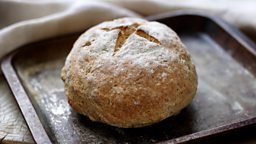
What’s in soda bread?
Briony’s soda bread recipe is from her Irish nan, who had it passed down to her from her own mother. “This recipe was my great-grandmother’s recipe so it’s over a hundred years old,” she explains.
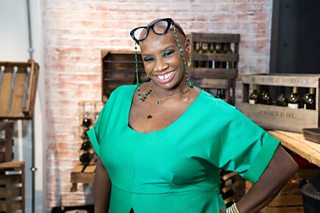
The recipe consists of plain flour (so you don’t even need special bread flour), a bit of salt, buttermilk and bicarbonate of soda.
If you don’t have buttermilk there’s a “cheeky trick”, Briony explains. “Get some milk, squeeze some lemon in it, leave it five minutes.” The process of acidulation sours up the milk and leaves it with a slightly curdled, thicker consistency.
The bicarbonate of soda is for the lift, in lieu of yeast. “The bicarb reacts with the lemon, or the acidity in the butter milk, and that’s what makes the rise.”
The science of soda bread
Nutritionist Kimberley Wilson explains a little more about the science.
“Traditional breads rely on the action of living yeasts to make them rise, whether that’s the wild yeast of sourdough or cultivated baking yeast (a species called Saccharomyces cerevisiae) for standard loaves,” she says. “What happens is that the yeast converts the sugars in the flour into carbon dioxide gas and as the gas expands and tries to escape it gets trapped in the dough, and it’s these bubbles of gas that cause the dough to rise. By contrast, quick breads use a chemical reaction to create the bubbles that raise the dough.”
“The benefit of these quick-raising agents is that they are particularly suited to low-gluten flours,” explains Kimberley. “When you’re making a standard loaf and you’re kneading the dough, what you’re doing is developing the gluten, a stretchy protein. And it’s the stretchiness of gluten that allows the bread to rise and to expand without collapsing.”
Back when soda bread became popular, the main types of flour in the UK would have been things like oat or barley, which have no or low gluten, and even the wheat flour was pretty low in gluten too. “The flours that were available really suited quick-raising and this helped to popularise soda bread across Ireland.”
Soda bread didn’t actually originate in Ireland
Briony’s nan grew up on a farm in rural Northern Ireland and her great-grandma – known as Granky – would make this exact recipe every day when her daughter got home from school. She made it for the workers on the farm because they had cows (so they had fresh buttermilk), it was a traditional recipe and it was cheap.
In the 19th century, it was thought that cutting a cross into the bread would protect the household by letting the devil out while the bread baked.
But although soda bread has long been a traditional food in Ireland, it didn’t actually originate on the Emerald Isle. In fact, it was first made by settlers in America in the 18th century.
“They didn’t have access to any yeast and they discovered that potash, which is literally what it sounds like – an extract from the residue of wood fires – made a really good leavening agent,” says Andi. (One way to make it is to take the ashes from the fire, put them in a large pan, and cover them with water. Then, skim off the water, boil it down and you’re left with white crystals: potassium carbonate or potash.)
The American settlers, some of whom were from Ireland, brought it back to their homeland – and that’s when the strong connection between Ireland and soda bread was born.
Soda bread has a cross on the top to dispel evil spirits
“Soda bread always has a cross on the top and that is to dispel bad spirits,” says Andi. In the 19th century, it was thought that cutting a cross into the bread would protect the household by letting the devil out while the bread baked.
In fact, there’s a practical reason behind it: “It’s actually because the dough is quite heavy and if it’s not cut the dough will pop the air bubbles and it won’t give you the rise,” Andi explains. “There’s no room for the bicarb to do its magic basically. So really you’re releasing the spirit of the bicarb!”
Some regions of Ireland prefer a flat “farl” to a loaf
Soda bread is shaped differently, depending on where in Ireland it’s being prepared.
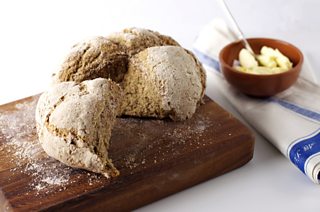
In the south they prefer a “cake”. The bread is formed into a round shape (crossed on top, of course) and then baked in the oven.
Whereas in Northern Ireland people favour the “farl”, which comes from the Gaelic word “fardel” meaning four parts. The dough is rolled into a round disc, cut into four equal triangular pieces, and then cooked dry on a flat griddle.
This harks back to the time when many Irish families lived in isolated rural areas with no access to ovens. The bread was cooked in three-legged iron pots or baked on griddles over the open fire.
Soda bread is a blank canvas
Soda bread can be eaten with slatherings of butter, jam or just about anything. But you can bake things into it too.
For Irish-Americans, a traditional soda bread often contains raisins and aromatic carraway seeds.
Briony has been known to “muck about” with her family recipe. “It is quite a plain base. It’s got flavour; it’s got taste but it’s quite plain, so if you want to chuck some other stuff in there why not?” she suggests. “I’ve done a Waldorf salad soda bread.” Not with lettuce, she’s keen to point out, but with nuts, grated apple and cheese.
Andi has made a soda bread with wild garlic, and once with plantain. “I boiled the plantain and mashed it up and just put it through,” says the chef. “I thought, is it going to be too heavy? Will I be able to take someone out at thirty paces with my loaf of soda bread? And actually, it was just delicious.”
From rustic with love
Plain or filled, a soda bread has a rustic look, but both Briony and Andi agree this means there’s just as much or even more love put into it as any standard loaf – especially when it’s a recipe passed down the generations.
“There’s not very many ingredients in a soda bread but just the act of making it – you channelling Granky – all of that is inherent within the taste and the flavour and the experience of eating it,” says Andi to her guest.
Listen to One Dish on ���˿��� Sounds. Future episodes will feature Cheryl Hole talking about lasagne, Phil Wang discussing Wat Tan Hor, Moqueca fish pie with Ixta Belfrage and many more.
More from ���˿��� Radio 4
-
![]()
One Dish
What’s the one dish that holds a special place in your heart?
-
![]()
The Food Programme - Perfect Bread
Sheila Dillon dissects our national loaf.
-
![]()
Saturday Live - Andi Oliver
Musician, cook and presenter Andi Oliver.
-
![]()
Desert Island Discs - Dame Prue Leith
Dame Prue Leith, writer and former restaurateur.
